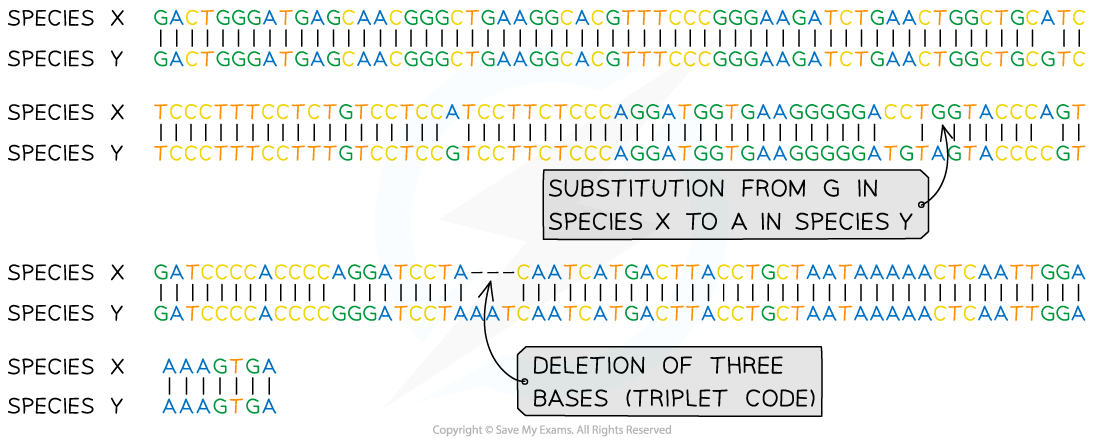Theory of Evolution (Cambridge (CIE) A Level Biology): Revision Note
Exam code: 9700
Theory of evolution
A species can be defined as a group of organisms that are able to interbreed and produce fertile offspring
Members of one species are reproductively isolated from members of another species
In reality, it is quite hard to define ‘species’ and the determination of whether two organisms belong to the same species is dependent on investigation
Individuals of the same species have similar behavioural, morphological (structural) and physiological (metabolic) features
A common example used to illustrate this concept is mules; the infertile offspring produced when a male donkey and a female horse mate
The gene pool
The phenotype of all organisms is dependent on its genotype and environmental influence on this
Members of the same species will have the same genes, of which there may exist alleles (alternate versions)
A gene pool is the collection of genes within an interbreeding population
A gene pool can be thought of as the sum of all the alleles at all of the loci within the genes of a population of a single species or a population
Changes to the gene pool
The gene pool (or allele frequencies) in a species population can change over time due to processes such as:
Natural selection
Genetic drift
The founder effect
When the gene pool within a species population changes sufficiently over time, the characteristics of the species will also change
The change can become so great that a new species forms
This is evolution
For a population to have evolved into a separate species it must be genetically and reproductively isolated from the pre-existing species population
Reproductive isolation can occur due to mutations that lead to the incompatibility of gametes or sex organs, or differences in breeding behaviour.
When two populations are reproductively isolated, they can also be said to be genetically isolated from each other, meaning that they do not exchange genes with each other in the production of offspring
Changes in the allele frequencies of isolated populations are not shared so they evolve independently of each other; this can lead to the formation of two groups that are no longer successfully able to interbreed and that are said to be separate species
The formation of new species in this way is known as speciation
The evolution of a new species can take a very long time and many generations
For organisms with a short generation time (such as bacteria), the evolution of new species can be observed far more quickly
Evidence of evolutionary relationships in DNA
DNA found in the nucleus, mitochondria and chloroplasts of cells can be sequenced and used to show evolutionary relationships between species
The differences between the nucleotide sequences (DNA) of different species can provide a lot of information:
The more similar the sequence the more closely related the species are
Two groups of organisms with very similar DNA will have separated into separate species more recently than two groups with less similarity in their DNA sequences
DNA sequence analysis and comparison can also be used to create family trees (phylogenetic trees) that show the evolutionary relationships between species

DNA analysis and comparison
DNA is extracted from the nuclei of cells taken from an organism
DNA can be extracted from blood or skin samples from living organisms or from fossils
The extracted DNA is processed, analysed and the base sequence is obtained
The base sequence is compared to that of other organisms to determine evolutionary relationships
The more similarities there are in the DNA base sequence, the more closely related (in that the less distant the species separation) members of different species are
In 2005, the chimpanzee genome was sequenced, and when compared to the human genome it was discovered that humans and chimpanzees share almost 99% of their DNA sequences, making them our closest living relatives
In 2012, the sequencing of the bonobo genome also revealed that humans and bonobos also share 98% of their genome (with slight differences from the differences seen in chimpanzees)

Mitochondrial DNA
When analysing DNA from the mitochondria, is important to remember that:
A zygote only contains the mitochondria of the egg and none from the sperm so only maternal mitochondrial DNA is present in a zygote
There is no crossing over that occurs in mtDNA so the base sequence can only change by mutation
The lack of crossing over in mtDNA has allowed scientists to research the origins of species, genetic drift and migration events
It has even been possible to estimate how long ago the first human lived and where
Mitochondrial Eve is thought to have lived in Africa ~200,000 years ago
The estimation of this date relies on the molecular clock theory which assumes there is a constant rate of mutation over time
The greater the number of differences there are between nucleotide sequences, the longer ago the common ancestor of both species existed
The molecular clock is calibrated by using fossils and carbon dating
A fossil of a known species is carbon-dated to estimate how long ago that organism lived
The mtDNA of this species is then used as a baseline for comparison with the mtDNA of other species
Although for your exams you should say that only maternal mitochondrial DNA can be passed on or inherited by the zygote, recent research suggests that paternal mDNA may also be present in zygotes

Unlock more, it's free!
Did this page help you?